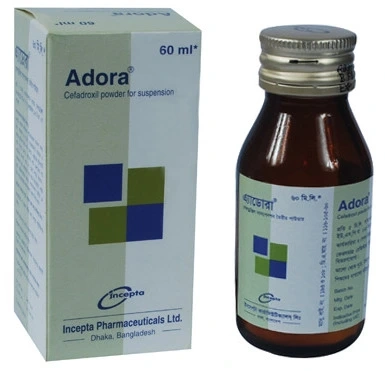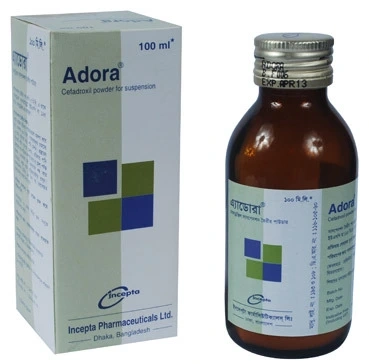Adora Powder for Suspension
Pack Images
125 mg/5 ml
60 ml bottle:
৳ 65.00
100 ml bottle:
৳ 95.00
Antibiotic
Do not use without prescription
of a registered physician
of a registered physician
Also available as:
Indications
Adora is indicated in the treatment of the following infections.
- Streptococcal pharyngitis and tonsillitis
- Bronchopneumonia, bacterial pneumonia
- Uncomplicated urinary tract infections: pyelonephritis, cystitis
- Skin and soft tissue infections: abscesses, furunculosis, impetigo, erysipelas, pyoderma, lymphadenitis.
* রেজিস্টার্ড চিকিৎসকের পরামর্শ মোতাবেক ঔষধ সেবন করুন
Pharmacology
Cefadroxil inhibits bacterial cell wall synthesis by binding to 1 or more of the penicillin-binding proteins (PBPs) which in turn inhibit the final transpeptidation step of peptidoglycan synthesis in bacterial cell walls, thus inhibiting cell wall biosynthesis and arresting cell wall assembly resulting in bacterial cell death.
Dosage & Administration
The dosage of Cefadroxil depends on the susceptibility of the pathogens, the severity of the disease and on the clinical status of the patient (renal and hepatic function).
Streptococcal pharyngitis and tonsillitis-
Renal impairment patients: In patients with renal impairment, the dose should be adjusted according to creatinine clearance rates to prevent accumulation of cefadroxil. In patients with creatinine clearance of 50 ml/min or less, the following reduced dosage schedule is recommended as a guideline.
Duration of therapy: Treatment should be applied for 2 to 3 further days after regression of the acute clinical symptoms or evidence of bacterial eradication has been obtained. In infections caused by Streptococcus pyogenes up to 10 days treatment may be considered.
Streptococcal pharyngitis and tonsillitis-
- Adult and adolescents >40 kg with normal renal function: 1000 mg once a day over at least 10 days. Dosage may be decreased.
- Children <40 kg with normal renal function: 30 mg/kg/day once a day over at least 10 days.
- Adult and adolescents >40 kg with normal renal function: 1000 mg twice a day.
- Children <40 kg with normal renal function: 30-35 mg/kg/day divided into two daily doses.
Renal impairment patients: In patients with renal impairment, the dose should be adjusted according to creatinine clearance rates to prevent accumulation of cefadroxil. In patients with creatinine clearance of 50 ml/min or less, the following reduced dosage schedule is recommended as a guideline.
- Creatinine clearance 50-25 ml/min/1.73 m2: 500 mg-1000 mg every 12 hours
- Creatinine clearance 25-10 ml/min/1.73 m2: 500 mg-1000 mg every 24 hours
- Creatinine clearance 10-0 ml/min/1.73 m2: 500 mg-1000 mg every 36 hours
- Children (<40 kg) with renal impairment: Cefadroxil is not indicated in children suffering from renal insufficiency and children requiring haemodialysis.
- Dosage for haemodialysis patients: Haemodialysis eliminates 63% of 1000 mg of cephalosporin after 6 to 8 hours of haemodialysis. Elimination half-time of cephalosporin is about 3 hours during dialysis. Patients with haemodialysis receive one additional dose ofcefadroxil 500 mg-1000 mg at the end of the haemodialysis.
- Elderly: As cefadroxil is excreted by renal route, the dosage should be adjusted if necessary as described under impaired renal function.
Duration of therapy: Treatment should be applied for 2 to 3 further days after regression of the acute clinical symptoms or evidence of bacterial eradication has been obtained. In infections caused by Streptococcus pyogenes up to 10 days treatment may be considered.
* রেজিস্টার্ড চিকিৎসকের পরামর্শ মোতাবেক ঔষধ সেবন করুন
Interaction
Prothrombin time will be prolonged; bleeding may occur when taken with anticoagulants. Decreased elimination with Probenecid is also reported.
Contraindications
Cefadroxil is contraindicated in patients with a history of hypersensitivity to any of the Cephalosporins. It is also contraindicated in patients with a history of severe reactions to penicillins or to any other beta lactam drugs.Cefadroxil should not be combined with bacteriostatic antibiotics (e.g. tetracycline, erythromycin, sulfonamides, chloramphenicol) since an antagonistic effect is possible.Treatment with cefadroxil in combination with aminoglycoside antibiotics, polymyxin B, colistin or high-dose loop diuretics should be avoided since such combinations can potentiate nephrotoxic effects.
Cefadroxil does not penetrate in the CSF and is not indicated for the treatment of meningitis. Penicillin is the first drug of choice for the treatment of the Streptococcus pyogenes and for the prevention of rheumatic fever. Data for cefadroxil are not Sufficiently substantial for prophylaxis therapy. Special caution should be exercised in patients with history of severe allergies or asthma. In patients with a history of non severehypersensitity to penicillins, or other non-cephalosporin beta-lactam drugs, cefadroxil should be used with special caution. Caution is necessary in patients with renal impairment; the dosage must be adjusted according to the grade of renal impairment. Cefadroxil should be used with caution in patients with a history of gastro-intestinal disturbances, particularly colitis. The occurrence of diarrhoea may impair the resorption of other medicaments and therefore lead to an impairment of their efficacy. Treatment must be discontinued at once if allergic reactions occur (urticaria, exanthema, pruritus, fall of blood pressure and increased heart rate, respiratory disturbances, collapse, etc.) and suitable countermeasures should be taken (sympathomimetics, corticosteroids and/or antihistaminics). Particularly on prolonged use frequent checks on the blood count and regular hepatic and renal function tests are advisable.Superinfections with fungi (e.g. candida) can occur on prolonged treatment with cefadroxil. In case of severe and persistent diarrhoea, an antibiotic-associated pseudomembranous colitis should be considered. In that case Cefadroxil must be discontinued immediately and a suitable therapy should be started. The result of the Coombs’ test can be transiently positive during or after treatment with cefadroxil. This also applies to Coombs’ tests carried out in newborns whose mothers received treatment with cephalosporins before delivery. Urinary sugar should be determined enzymatically (e.g. with test strips) during treatment with cefadroxil since reduction tests can furnish falsely elevated values.
Cefadroxil does not penetrate in the CSF and is not indicated for the treatment of meningitis. Penicillin is the first drug of choice for the treatment of the Streptococcus pyogenes and for the prevention of rheumatic fever. Data for cefadroxil are not Sufficiently substantial for prophylaxis therapy. Special caution should be exercised in patients with history of severe allergies or asthma. In patients with a history of non severehypersensitity to penicillins, or other non-cephalosporin beta-lactam drugs, cefadroxil should be used with special caution. Caution is necessary in patients with renal impairment; the dosage must be adjusted according to the grade of renal impairment. Cefadroxil should be used with caution in patients with a history of gastro-intestinal disturbances, particularly colitis. The occurrence of diarrhoea may impair the resorption of other medicaments and therefore lead to an impairment of their efficacy. Treatment must be discontinued at once if allergic reactions occur (urticaria, exanthema, pruritus, fall of blood pressure and increased heart rate, respiratory disturbances, collapse, etc.) and suitable countermeasures should be taken (sympathomimetics, corticosteroids and/or antihistaminics). Particularly on prolonged use frequent checks on the blood count and regular hepatic and renal function tests are advisable.Superinfections with fungi (e.g. candida) can occur on prolonged treatment with cefadroxil. In case of severe and persistent diarrhoea, an antibiotic-associated pseudomembranous colitis should be considered. In that case Cefadroxil must be discontinued immediately and a suitable therapy should be started. The result of the Coombs’ test can be transiently positive during or after treatment with cefadroxil. This also applies to Coombs’ tests carried out in newborns whose mothers received treatment with cephalosporins before delivery. Urinary sugar should be determined enzymatically (e.g. with test strips) during treatment with cefadroxil since reduction tests can furnish falsely elevated values.
Side Effects
Infections and infestations: Uncommon side effects are Vaginal mycoses, thrush. Blood and lymphatic system disorders: Rare side effects are eosinophilia, thrombocytopenia, leucopenia, neutropenia, agranulocytosis and very rarely occurs haemolytic anemia.
Immune system disorders: Rarely occur serum sickness-like reactions, Very rarely occur immediate allergic reaction (anaphylactic shock).
Nervous system disorders: Very rare side effects are Headache, sleeplessness, dizziness, nervousness.
Gastrointestinal disorders: Common side effects are nausea, vomiting, diarrhoea, dyspepsia, abdominal pain, glossitis and very rarely occurs Pseudomenbranous colitis.
Hepatobiliary disorders: Rarely occurs cholestase and idiosyncratic hepatic failure.
Skin and subcutaneous tissue disorders: Pruritus, rash, allergic exanthema, urticaria are common side effects. Very rarely occurs stevens Johnson syndrom and erythema multiforma.
Musculoskeletal and connective tissue disorders: Rarely occur arthralgia. Renal and urinary disorders: Rarely occurInterstitial nephritis.
General disorders: Fever is rare and fatigue is very rare.
Immune system disorders: Rarely occur serum sickness-like reactions, Very rarely occur immediate allergic reaction (anaphylactic shock).
Nervous system disorders: Very rare side effects are Headache, sleeplessness, dizziness, nervousness.
Gastrointestinal disorders: Common side effects are nausea, vomiting, diarrhoea, dyspepsia, abdominal pain, glossitis and very rarely occurs Pseudomenbranous colitis.
Hepatobiliary disorders: Rarely occurs cholestase and idiosyncratic hepatic failure.
Skin and subcutaneous tissue disorders: Pruritus, rash, allergic exanthema, urticaria are common side effects. Very rarely occurs stevens Johnson syndrom and erythema multiforma.
Musculoskeletal and connective tissue disorders: Rarely occur arthralgia. Renal and urinary disorders: Rarely occurInterstitial nephritis.
General disorders: Fever is rare and fatigue is very rare.
Pregnancy & Lactation
Although animal studies and clinical experience have not shown any evidence of teratogenicity, the safe use during pregnancy has not been established. Cefadroxil is present in low concentrations in breast milk; sensitization, diarrhoea or colonization of the infants’ mucosa with fungi are possible. The use of cefadroxil during pregnancy and in lactating mothers should therefore be handled very strictly.
Precautions & Warnings
Adora binds to cholestyramine which may lead to reduced bioavailability of cefadroxil. The concomitant administration of probenecid reduces the renal elimination of cefadroxil; therefore, plasma concentrations of cefadroxil may be increased when given in combination with probenecid.
Overdose Effects
No clinical reports are as yet available on cefadroxil in this respect. However in view of experience gained with other cephalosporins the following symptoms are possible: nausea, hallucinations, hyperreflexia, extrapyramidal symptoms, clouded consciousness, or even coma and renal functional impairment.
Therapeutic Class
First generation Cephalosporins
Storage Conditions
Keep in a dry place away from light and heat. Keep out of the reach of children.
Pack Images: Adora 125 mg Suspension


